10 Tips for great vacation photos
When we're going away on vacation, we like to get some great photos to remember the great time we had and interesting things we saw. However, sometimes we can't remember why we took a certain shot. Other times we can remember, but the photo doesn't really show what it was meant to.
Here are ten tips to help you avoid these problems, and get some great vacation photos.
Plan ahead
If you want to get some great photos while you're on vacation, it is a good idea to plan ahead. Look in guidebooks and on the internet for the 'must see' photo opportunities. Think about how you would like to capture these sorts of photos.
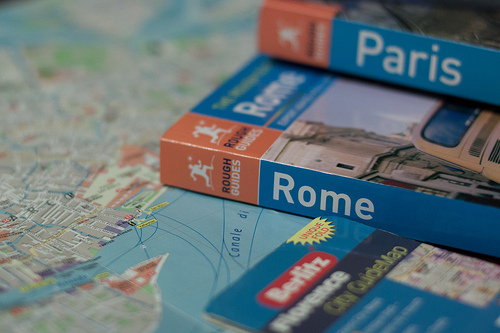
Vacation Planning [121/366] by timsackton (on vacation) on flickr (licensed CC-BY-SA)For example, you might find a wildlife park is highly recommended, so you can pack a camera / lens with a long zoom. Or you might see there is a famous market area, and so decide to take a camera / lens that will allow for wide angle shots. By planning ahead you can make sure you are prepared for the shots you will want to capture.
Another good idea is to do a search for the name of the area you will be visiting on websites like panoramio and flickr. This will show photos taken by other people around that area. Looking at other's photos is a good way to discover potentially interesting subjects not covered by guidebooks.
Be careful with memory / batteries
As part of the planning for your trip, you need to look at memory and batteries for your camera. Unless you are sure that you can easily buy more compatible memory cards when you are away, it is a good idea to make sure you have more than enough memory before you leave.
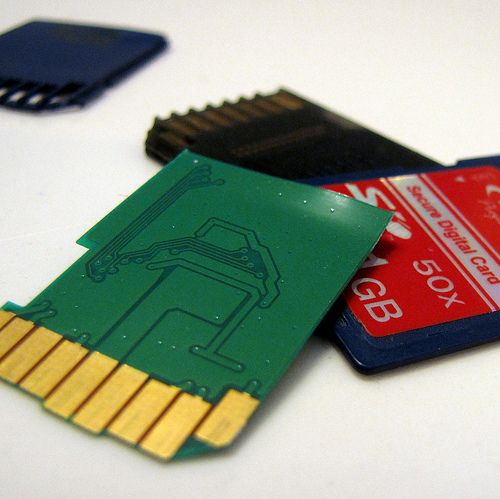
memories by jasleen_kaur on flickr (licensed CC-BY-SA)This could mean taking several memory cards to keep all the photos from the whole vacation. Or it might mean taking just one or two cards plus a laptop to copy the photos to at the end of each day so that card(s) can be reused.
It might be tempting to just use one very high capacity memory card to record all your photos onto. But remember that using only 1 card means a single point of failure. So if that memory card fails or is lost, then you would loose all your photos from the whole trip.
For battery power, you should check whether power will be available where you are staying, and any plug converters needed. Then you can take a battery charger and start each day with a freshly charged battery. I would recommend taking more than one battery as it will be very annoying if the battery runs out part-way through a day out.
Tell a story
Take lots of photos throughout the trip, so you can tell the story of your trip in photos. Record even the mundane things like waiting for a bus, or the queue for entry to an attraction.
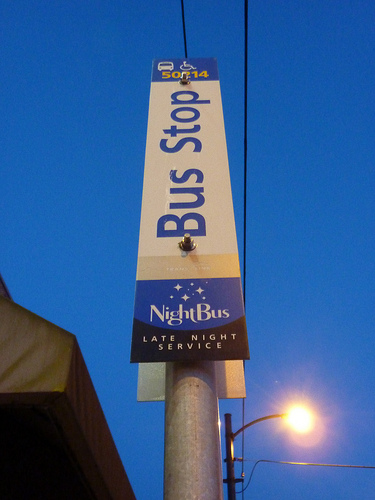
Bus Stop by Bods on flickr (licensed CC-BY-SA)These photos probably won't be particularly interesting in themselves. But when viewed as part of a story with the other photos, they can really bring the memories of the trip back, even years later.
Capture the local culture
Even if you're just going on vacation somewhere within your own country, the culture of an area can be quite different in some ways to what you are used to. Record these differences in your photos, to show what really makes the location special.
Talk to the locals as well, you may well be able to get tips on more interesting things to see or do that the guidebooks don't cover. They may even point out something in the immediate area that you would otherwise have missed.
Being friendly with the locals, you can also ask them if they don't mind having their photo taken. Try not to get them looking too posed though.
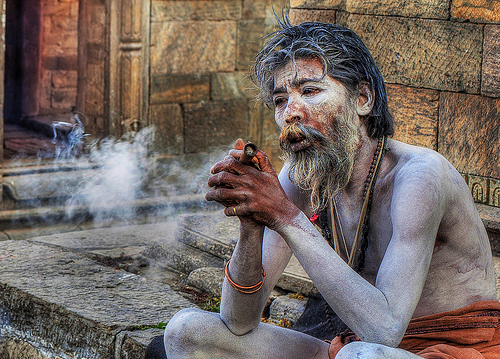
Aghori Contemplating... by MikeBehnken on flickr (licensed CC-BY-ND)Also look out for opportunities as well where you can capture a combination of local culture and something that you're used to. For example, a person in traditional clothing drinking a can of Coca Cola.
Record what you're photographing
When you look back at your photos in the future, it is nice to know what it is that the photos are of and where the photos were taken. It is a good idea to use a notebook to jot down the location and details of what you're photographing.
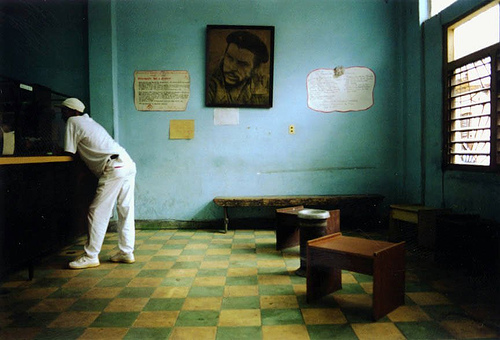
Conseguir raciones by Alex Barth on flickr (licensed CC-BY)What you can do is to write the name of the location as a header, then underneath write the filename of the first photo shot in that location. When you are done shooting in that location, you can add the filename of the last photo as well. So you know that all images between (and including) those two photos are of that location.
If you then take photos of a specific item or sublocation that is worthy recording details of, you can write that down along with the filename as well.
For example, say I went on vacation to London and went for a trip down Oxford Street. Then I went into the Selfridges department store, and took a few photos, including one of a very expensive designer dress. I might write:
- Oxford Street
- _DSC1920 -
- Selfridges
- _DSC1921 - _DSC1935
- _DSC1928 Designer dress by Anthony Worral-Thompson cost £10,000!
When you get back home, you can use image management software to add this information to your images, or organize the images according to the information. Alternatively, you could just type the information in a text document and store it with the photos.
Then when you come to look at the photos, or show a slideshow to your friends and family, you can explain what the different photos were of.
Another good idea for recording what you're photographing is to geotag your photos. Some cameras come with a built-in GPS to allow geotagging. Others can geotag photos with an external GPS unit.

Hut Sunrise - Hello from Kish Island by Hamed Saber on flickr (licensed CC-BY)Some cameras don't allow geotagging directly, but you can record a tracklog with an external GPS and then sync this with the photos later on the computer. Geotagged photos allow you to see exactly on a map where a photo was taken. For more information on geotagging, see this article: Using Geotagging To Map Your Photos.
- Oxford Street
Photograph your food
Take photos of your meals and snacks, especially the unique and different ones. Food is an important part of going on vacation, so don't neglect to record it.
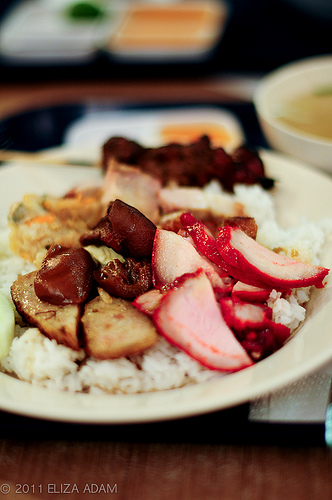
Nasi campur by 3liz4 on flickr (licensed CC-BY-ND)Take some close-up shots of the dishes, and also some wider shots of the restaurant area you're eating in. Food photos generally look better without direct flash. You can buy a small tabletop tripod and use that to steady your camera to allow shooting with available light.
Always carry your camera
Always carrying a camera to be able to capture unexpected photo opportunities is good advice anywhere. But particularly more so when on vacation, and you are more likely to come across unexpected photo opportunities more often.
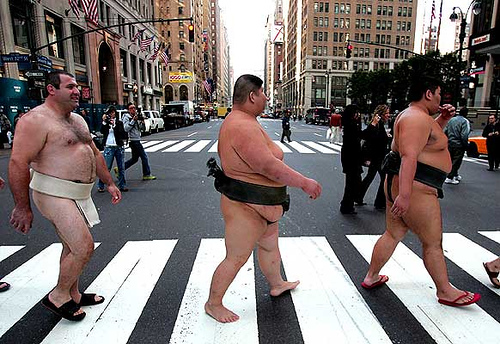
251238 by we-make-money-not-art on flickr (licensed CC-BY-SA)If you are taking a large / heavy camera with you, for example a DSLR and several lenses, you might want to take a small compact or a phone camera as well. This way you can have the compact camera always with you, even if you're just going out for an early morning run round the block and don't expect to be taking any photos.
Having said this, don't feel you always need to take photos though. Sometimes it can be nice to just get a quick shot of something, then put the camera away and focus on enjoying an event rather than photographing it.
Look for a theme
Shooting to a theme can get you thinking more creatively, as well as giving a series of photos that form more than the sum of their parts when viewed together.
When deciding on a theme to shoot, you want to be sure that you will be able to get photos that satisfy the theme. For example, it's no good to decide on a theme of houses with tiled roofs, then when you get there you find no houses have tiled roofs.
So choosing a good theme to shoot is best done either before-hand as part of your research, or after a day on vacation and noticing something that makes for a good theme. It is a good idea to choose a theme that fits in some way with the location you are visiting.
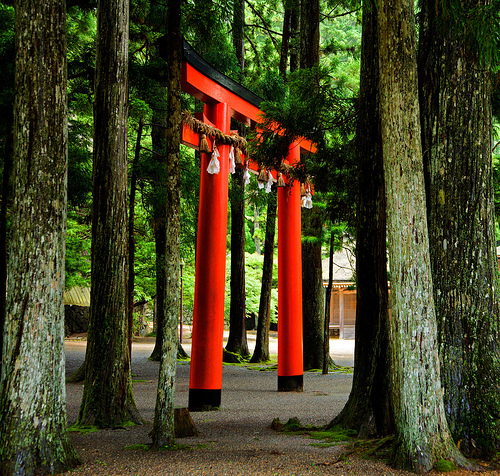
Koyasan 高野山 (Wakayama/Japan) by Chi King on flickr (licensed CC-BY)For example, if you were visiting Japan you might decide on a theme of capturing Torii gates. Or in India you might choose a theme of women wearing bright colorful clothes.
Protect and check your gear
Using a bag or case to protect your camera when not in use is a good idea, but make sure you keep an eye on it. Pickpockets and thieves often operate in tourist destinations. As part of your planning before the trip, check to see if there is much of a problem in the area where you are visiting.
If there is a problem, I would advise against using a backpack as thieves can open up and dip into a backpack without you noticing. Instead you can use a shoulder bag, and do the top zip up so that the zip pulls are at the front of the bag (where you can see them).
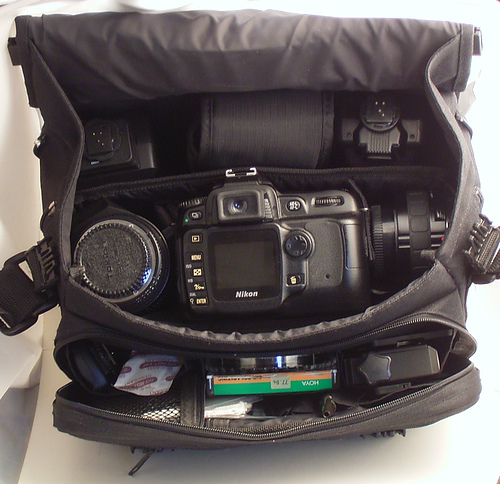
bag by Marc Lacoste on flickr (licensed CC-BY)If you rest your arm on top of the bag, or over any pockets, this makes it even harder for thieves to get at the bag. Some thieves are very nimble fingered, so you can't ensure you won't be pick pocketed, but by making yourself a difficult target you are more likely to be left alone.
As well as protecting your gear from thieves, you also need to protect it from dirt. Check regularly that your camera / lens is free from dust and smudges, and clean as necessary. I also would suggest cleaning your gear at the end of every day, even if it doesn't look like it needs it.
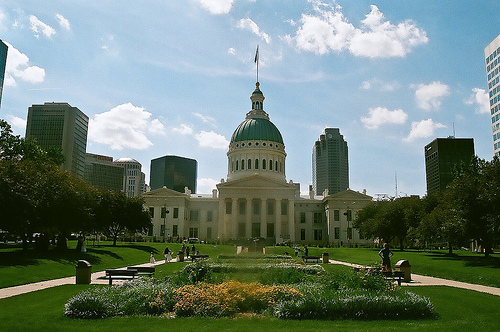
Old Courthouse by '|'||'| '|'[]||{ on flickr (licensed CC-BY)Smudges and dust spots on the camera sensor can be easy to miss when you're reviewing images on the small LCD of the camera. But you don't want to find out when you get back home that all your photos have a blob or mark from a piece of dirt somewhere on them. By cleaning your gear everyday, you can ensure this doesn't happen.
Take candid photos
Although it is much easier to get a photo of your family or friends by asking them to pose for the camera, candid shots can make for much better photos. Just taking shots of your family / friends enjoying themselves will give the images a much more natural and realistic feel than a forced smile in a posed shot can give.

Candid Capture - HBW by Vox Efx on flickr (licensed CC-BY)By taking lots of photos, your subjects should get more used to having their photo taken. This should result in them being more relaxed, and better pictures.
Following these tips you should be able to enjoy your vacation, and come back with some great shots to share with family and friends.




